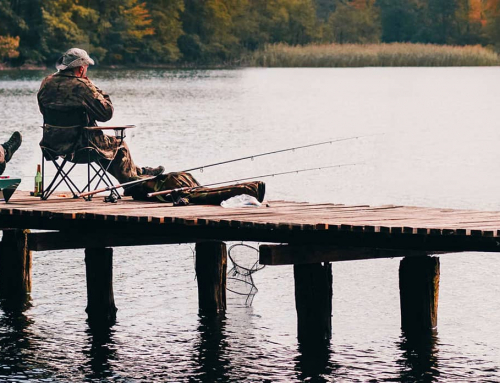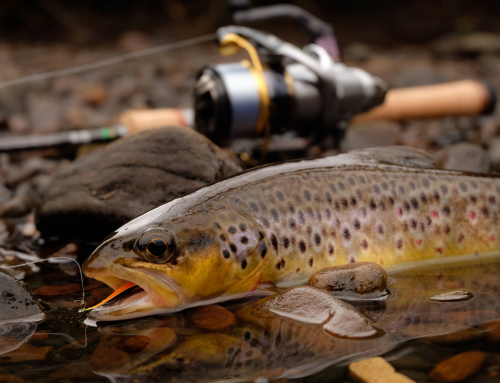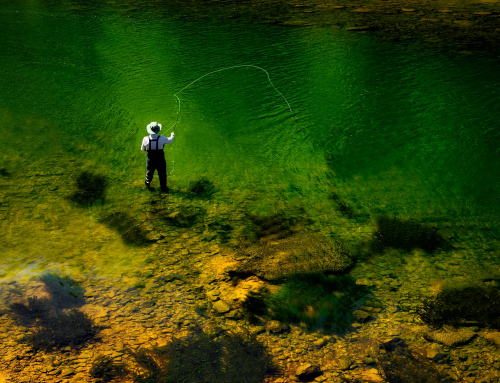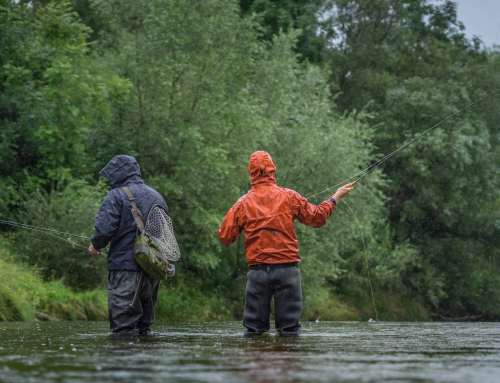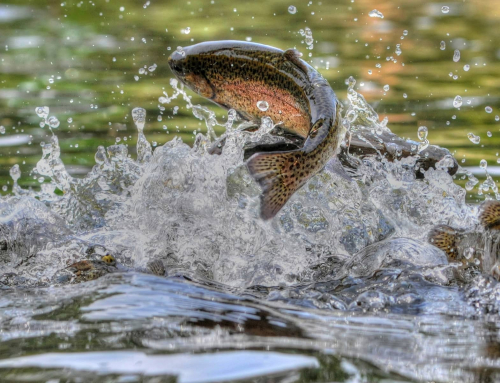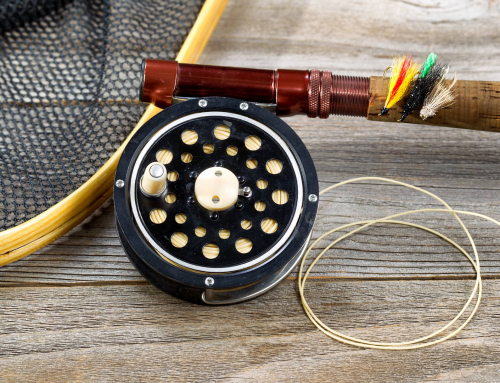We may earn money or products from the companies mentioned in this post at no additional cost to you.
How to Reel in a Fish Fly Fishing
Take a seasoned angler and hand them a fly rod and reel for the first time – what do you think will happen? Chances are they’ll do only slightly better than anyone else picking up fly fishing for the first time.
Though they both involve a rod, reel, and line, traditional angling and fly fishing have major differences including how to find fish and reel them in. If you hit the water for the first time without researching fly fishing-specific techniques – you’re going to get skunked.

There are many techniques to learn for fly fishing but one of the most basic is how to reel in a fish while fly fishing. Let’s learn what makes reeling in a fly line different, tips on using your rod and reel to your advantage, and how to reel in big fish on a fly rod. You can’t master these techniques without practice but knowing what to do is a great start.
Do You Reel in a Fly Rod?
Yes, you reel in a fly rod, but not like a traditional spinning reel. Fly fishers are mostly targeting fish that are only a few yards away, so reeling is not as necessary to someone fishing at a target fifty yards out. How much you use your reel depends on far away the fish is and what type of fight it’s putting up. In many cases you won’t reel at all.
Why Reeling a Fly Line is Different
Different Construction – A fly reel is not designed for cranking in the line at full speed. While most spin reels have large reel handles that let you reel in a fish quickly, fly reels have a small reel handle. This is by design since you aren’t supposed to ‘grip and rip’ while fly fishing.
Different Species – Many fly-fishing species like trout are more delicate than other freshwater fish like bass. Because trout aren’t as robust as other fish you want to avoid cranking them in. Fly fishing species that are yanked around and dragged over rocks might not make it for the next angler.
Reeling in fish on a fly rod
When fly fishing anglers retrieve the line, they use two methods:
Stripping in Line – Bringing in the line by hand. Most effective way to retrieve line when the fish is only a few yards away or less. Gives great control for landing. Anglers will often switch between stripping and reeling.
Reeling – If the fish is too far away or taking too much slack you should use the reel. As discussed earlier, fly reels don’t operate like conventional spinning reels and need even, smooth reeling. You should reel fast enough to keep tension on the line but not so much where you can feel the line straining. Reels on fly lines are more designed for reducing slack over doing the primary work of bringing the fish in.
Using Your Reel’s Drag
Fly rods come with drag systems to decrease or increase tension on the line. A few ticks up or down can make a huge difference in fighting trophy fish, so you want to get well acquainted on how effective your drag system is and what type of tension it produces.
How to Fight a Fish on a Fly Rod
Learning how to fight a fish takes a lifetime of practice but we can help get you started with time-tested techniques.
- Get Ready – The first time you get a big hit you can get overeager to reel or start pulling your line but the first thing you need to do is take a breath and get ready for a fight.
- Move with the Fish – One of the worst things you can do is let your fish move several yards downstream so stay with your fish the best you can. Modern boots and waders let anglers nimbly jump downstream and over brush and rocks.
- Angling Your Rod Correctly – Angling your rod correctly helps keep the fish from going into brush or under rocks. You want to keep your rod tip up and aimed at the fish.
- Watch Your Drag – Setting your drag at the proper tension is one of the best ways to quickly change the fight. You want to check your drag before the fish hits, but you can check it throughout the fight to take or add a couple pounds of pull.
- Watch Your Tension – You don’t want the line to be at its breaking point but its best to keep tension while fighting a fish. Keeping tension helps avoid tangling your line or getting your rod yanked away when the fish turns.
- Use Water to Your Advantage – This takes practice but if you can level your rod to the downstream side, you’ll make the fish work against your rod’s tension and water current. All that work will tire the fish faster.
- Know Where You’re Landing – It will be much easier to land a fish if you’ve picked out a great spot. During the fight keep your head on a swivel to find landing spots and communicate with your net minder where you plan on finishing the fight.
- Take Your Time at the End – When a fish is only a few feet away it can be easy to rush the landing or yank the line in, but experienced anglers know fish are likely to make a ‘final run’ at the end. Keep your head about you during these final minutes and only attempt to land the fish headfirst.
- Keep Trying – Like anything else practice makes perfect, or progress in the case of fly fishing. The more you fish the more you’ll learn the right ways to fight and how to land a trophy. Don’t get discouraged if you lose a fish – try again.
Taking Fly Fishing Lessons
If you’ve learned about reading the water and making the perfect cast, you’re ready for lessons on reeling in a fish. Taking lessons or fishing with a guide for your first live action greatly increases your chances of finding, reeling in, and landing fish. If you’re unsure if you want to pursue fly fishing as a hobby many lessons provide complimentary equipment.
How to Reel in a Fish on a Fly Rod
Though there are several instances in which you’ll pull your line in by hand there are many others when you need to use the fly reel and drag to your advantage. Practice with your reel at a local park, take lessons, and get as much practice as possible fighting fish. With a few days on the river or lake you’ll learn the ins and outs of your reel and the best ways to land monster fish.
